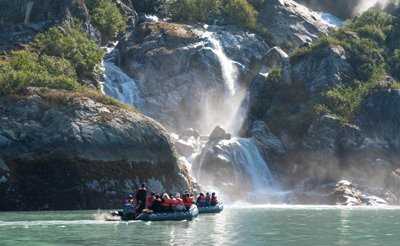It was an early morning for some staff and guests out on the bow of National Geographic Venture, with a cool katabatic wind flowing toward us from the South Sawyer Glacier – still some miles in front of us and out of view.
We passed by the Sawyer Glacier fjord on our port side and the steep fjord walls with exposures of folded and fractured metasedimentary and metavolcanics rock cut by vein swarms of granite. As recently as 15 years ago, the Sawyer Glacier was still visible from Tracy Arm before it receded around the corner and out of sight.
At 7:15, with an early morning sun coming over the peaks, the South Sawyer Glacier came into view accompanied by an increased concentration of brash ice and growlers. This glacier was our destination.
About two and a half miles from the glacier, we disembarked National Geographic Venture and loaded into Zodiacs for the cruise to investigate this tidewater glacier and the surrounding fjord. We motored through the full range of varieties of calved ice from the smallest brash ice and growlers to the larger bergy bits and largest icebergs.
On the way toward the glacier, we enjoyed sightings of a few mountain goats browsing on Sitka Alder on the steep mountain slopes including one location close to tidewater where a lamb and an ewe were grazing.
The South Sawyer Glacier descends to tidewater from the Stikine Ice Field. The Canadian border is some 18 miles east. At the Glacier terminus, we enjoyed a few modest calving events from the safe distance. Small groups of harbor seals curiously approached us, and others leisurely sunned themselves on icebergs. Fjords with tidewater glaciers offer good pupping grounds for harbor seals where they are under less pressure from killer whales and where the abundant icebergs offer a safer alternative to the shore where the bears roam.
While we watched the glacier and wildlife inhabitants, the Viking hot chocolate boat snuck up behind us and offered us a warm drink to help us endure the chilly morning.
Mew Gulls and Artic Terns were “working” the area just in front of the glacier, likely catching invertebrates brought to the surface when the calving glacier disturbed the muddy bottom below.
On our trip back to the Venture we could look high to the peaks and see horns – as in Matterhorn – that were left when the glaciers carved the landscape all around them. At the height of the last glacial stand, when the ice was as much as 4,000 ft. thick, these horns remained above the glacial ice surface as the only expressions of bedrock covered in ice.
After returning to the ship for lunch and repositioning a bit farther down the fjord, hardy guests and crew enjoyed the expedition Polar Plunge. It was a treat for those plunging or viewing alike.
Finally, we enjoyed watching resident Orcas travel near the mouth of Tracy Arm just before recap and dinner. The skies remained mostly clear all day and by afternoon, it was very warm.







